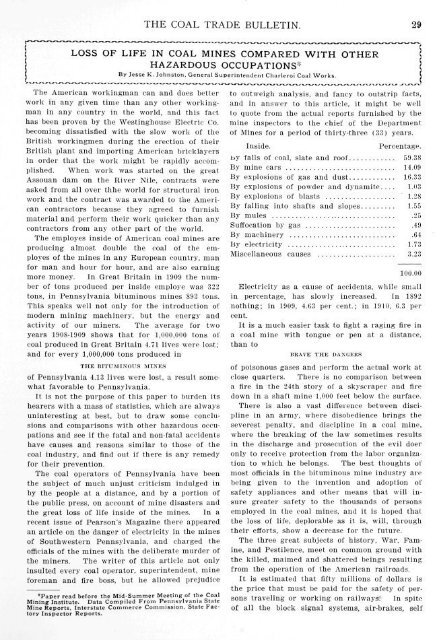u,.:- • - Clpdigital.org
u,.:- • - Clpdigital.org
u,.:- • - Clpdigital.org
Create successful ePaper yourself
Turn your PDF publications into a flip-book with our unique Google optimized e-Paper software.
THE COAL TRADE BULLETIN. 29<br />
LOSS OF LIFE IN COAL MINES COMPARED WITH OTHER<br />
HAZARDOUS OCCUPATIONS*<br />
By Jesse K. Johnston, General Superintendent Charleroi Coal Works.<br />
The American workingman can and does better<br />
work in any given time than any other workingman<br />
in any country in the world, and this fact<br />
has been proven by the Westinghouse Electric Co.<br />
becoming dissatisfied with the slow work of the<br />
British workingmen during the erection of their<br />
British plant and importing American bricklayers<br />
in order that the work might be rapidly accomplished.<br />
When work was started on the great<br />
Assouan dam on the River Nile, contracts were<br />
asked from all over thhe world for structural iron<br />
work and the contract was awarded to the American<br />
contractors because they agreed to furnish<br />
material and perform their work quicker than any<br />
contractors from any other part of the world.<br />
The employes inside of American coal mines are<br />
producing almost double the coal of the employes<br />
of the mines in any European country, man<br />
for man and hour for hour, and are also earning<br />
more money. In Great Britain in 1909 the number<br />
of tons produced per inside employe was 322<br />
tons, in Pennsylvania bituminous mines 893 tons.<br />
This speaks well not only for the introduction of<br />
modern mining machinery, but the energy and<br />
activity of our miners. The average for two<br />
years 1908-1909 shows that for 1,000.000 tons of<br />
coal produced in Great Britain 4.71 lives were lost;<br />
and for every 1,000,000 tons produced in<br />
THE BITUMINOUS MINES<br />
of Pennsylvania 4.13 lives were lost, a result somewhat<br />
favorable to Pennsylvania.<br />
It is not the purpose of this paper to burden its<br />
hearers with a mass of statistics, which are always<br />
uninteresting at best, but to draw some conclusions<br />
and comparisons with other hazardous occupations<br />
and see if the fatal and non-fatal accidents<br />
have causes and reasons similar to those of the<br />
coal industry, and find out if there is any remedy<br />
for their prevention.<br />
The coal operators of Pennsylvania have been<br />
the subject of much unjust criticism indulged in<br />
by the people at a distance, and by a portion of<br />
the public press, on account of mine disasters and<br />
the great loss of life inside of the mines. In a<br />
recent issue of Pearson's Magazine there appeared<br />
an article on the danger of electricity in the mines<br />
of Southwestern Pennsylvania, and charged the<br />
officials of the mines with the deliberate murder of<br />
the miners. The writer of this article not only<br />
insulted every coal operator, superintendent, mine<br />
foreman and fire boss, but he allowed prejudice<br />
"Paper read before the Mid-Summer Meeting of the Coal<br />
Mining Institute. Data Compiled From Pennsylvania State<br />
Mine Reports, Interstate Commerce Commission. State Factory<br />
Inspector Reports.<br />
to outweigh analysis, and fancy to outstrip facts,<br />
and in answer to this article, it might be well<br />
to quote from the actual reports furnished by the<br />
mine inspectors to the chief of the Department<br />
of Mines for a period of thirty-three (33) years.<br />
Inside. Percentage.<br />
by falls of coal, slate and roof 59.38<br />
By mine cars 14.09<br />
By explosions of gas and dust 16.33<br />
By explosions of powder and dynamite.... 1.03<br />
By explosions of blasts 1.2S<br />
By falling into shafts and slopes 1.55<br />
By mules .25<br />
Suffocation by gas .49<br />
By machinery .64<br />
By electricity 1.73<br />
Miscellaneous causes 3.23<br />
100.00<br />
Electricity as a cause of accidents, while small<br />
in percentage, has slowly increased. In 1892<br />
nothing; in 1909, 4.63 per cent.; in 1910. 0.3 per<br />
cent.<br />
It is a much easier task to fight a raging fire in<br />
a coal mine with tongue or pen at a distance,<br />
than to<br />
BRAVE THE DANGERS<br />
of poisonous gases and perform the actual work at<br />
close quarters. There is no comparison between<br />
a fire in the 24th story of a skyscraper and fire<br />
down in a shaft mine 1,000 feet below the surface.<br />
There is also a vast difference between discipline<br />
in an army, where disobedience brings the<br />
severest penalty, and discipline in a coal mine,<br />
where the breaking of the law sometimes results<br />
in the discharge and prosecution of the evil doer<br />
only to receive protection from the labor <strong>org</strong>anization<br />
to which he belongs. The best thoughts of<br />
most officials in the bituminous mine industry are<br />
being given to the invention and adoption of<br />
safety appliances and other means that will insure<br />
greater safety to the thousands of persons<br />
employed in the coal mines, and it is hoped that<br />
the loss of life, deplorable as it is, will, through<br />
their efforts, show a decrease for the future.<br />
The three great subjects of history. War. Famine,<br />
and Pestilence, meet on common ground with<br />
the killed, maimed and shattered beings resulting<br />
from the operation of the American railroads.<br />
It is estimated that fifty millions of dollars is<br />
the price that must be paid for the safety of persons<br />
traveling or working on railways. In spite<br />
of all the block signal systems, air-brakes, self
















